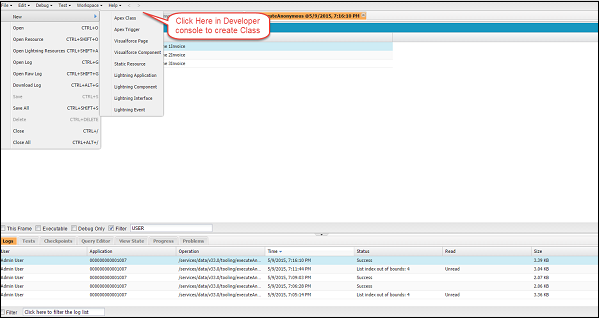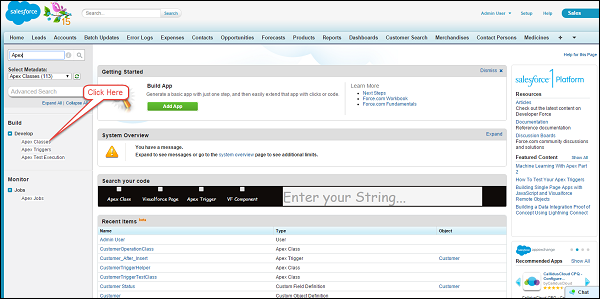Theoretical Paper
- Computer Organization
- Data Structure
- Digital Electronics
- Object Oriented Programming
- Discrete Mathematics
- Graph Theory
- Operating Systems
- Software Engineering
- Computer Graphics
- Database Management System
- Operation Research
- Computer Networking
- Image Processing
- Internet Technologies
- Micro Processor
- E-Commerce & ERP
Practical Paper
Industrial Training
Apex - Classes
What is a Class?
A class is a template or blueprint from which objects are created. An object is an instance of a class. This is the standard definition of Class. Apex Classes are similar to Java Classes.
For example, InvoiceProcessor class describes the class which has all the methods and actions that can be performed on the Invoice. If you create an instance of this class, then it will represent the single invoice which is currently in context.
Creating Classes
You can create class in Apex from the Developer Console, Force.com Eclipse IDE and from Apex Class detail page as well. From Developer Console
Follow these steps to create an Apex class from the Developer Console −Step 1 − Go to Name and click on the Developer Console.
Step 2 − Click on File ⇒ New and then click on the Apex class.

From Force.com IDE
Follow these steps to create a class from Force.com IDE −
Step 1 − Open Force.com Eclipse IDE
Step 2 − Create a New Project by clicking on File ⇒ New ⇒ Apex Class.
Step 3 − Provide the Name for the Class and click on OK.
Once this is done, the new class will be created.
From Apex Class Detail Page
Follow these steps to create a class from Apex Class Detail Page −Step 1 − Click on Name ⇒ Setup.
Step 2 − Search for 'Apex Class' and click on the link. It will open the Apex Class details page.

Apex Class Structure
Below is the sample structure for Apex class definition.Syntax
private | public | global
[virtual | abstract | with sharing | without sharing]
class ClassName [implements InterfaceNameList] [extends ClassName] {
// Classs Body
}
This definition uses a combination of access modifiers, sharing modes, class name and class body. We will look at all these options further.
Example
Following is a sample structure for Apex class definition −
public class MySampleApexClass { //Class definition and body
public static Integer myValue = 0; //Class Member variable
public static String myString = ''; //Class Member variable
public static Integer getCalculatedValue () {
// Method definition and body
// do some calculation
myValue = myValue+10;
return myValue;
}
}
Access Modifiers
Private
If you declare the access modifier as 'Private', then this class will be known only locally and you cannot access this class outside of that particular piece. By default, classes have this modifier.
Public
If you declare the class as 'Public' then this implies that this class is accessible to your organization and your defined namespace. Normally, most of the Apex classes are defined with this keyword.
Global
If you declare the class as 'global' then this will be accessible by all apex codes irrespective of your organization. If you have method defined with web service keyword, then you must declare the containing class with global keyword.
Sharing Modes
Let us now discuss the different modes of sharing.With Sharing
This is a special feature of Apex Classes in Salesforce. When a class is specified with 'With Sharing' keyword then it has following implications: When the class will get executed, it will respect the User's access settings and profile permission. Suppose, User's action has triggered the record update for 30 records, but user has access to only 20 records and 10 records are not accessible. Then, if the class is performing the action to update the records, only 20 records will be updated to which the user has access and rest of 10 records will not be updated. This is also called as the User mode.
Without SharingEven if the User does not have access to 10 records out of 30, all the 30 records will be updated as the Class is running in the System mode, i.e., it has been defined with Without Sharing keyword. This is called the System Mode.
Virtual
If you use the 'virtual' keyword, then it indicates that this class can be extended and overrides are allowed. If the methods need to be overridden, then the classes should be declared with the virtual keyword.
Abstract
If you declare the class as 'abstract', then it will only contain the signature of method and not the actual implementation.
Class Variables
Syntax[public | private | protected | global] [final] [static] data_type
variable_name [= value]
In the above syntax −
- Variable data type and variable name are mandatory
- Access modifiers and value are optional.
Example
public static final Integer myvalue;

